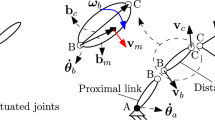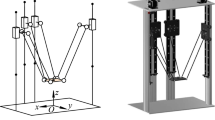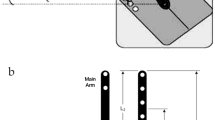Abstract
This paper presents a redundantly actuated and over-constrained 2RPU-2SPR parallel manipulator with two rotational and one translational coupling degrees of freedom. The kinematics analysis is firstly carried out and the mapping relationship of the velocity, acceleration and the independent parameters between the actuator joint and the moving platform are deduced by using the vector dot product and cross product operation. By employing d’Alembert’s principle and the principle of virtual work, the dynamics equilibrium equation is derived, and the simplified dynamics mathematical model of the parallel manipulator is further derived. Simultaneously, the generalized inertia matrix which can characterize the acceleration performance between joint space and operation space is further separated, and the performance indices including the dynamics dexterity, inertia coupling characteristics, energy transmission efficiency and driving force/torque balance are introduced. The analysis results show that the proposed redundantly actuated and over-constrained 2RPU-2SPR parallel manipulator in comparison with the existing non-redundant one has better dynamic comprehensive performance, which can be demonstrated practically by the successful application of the parallel kinematic machine head module of the hybrid machine tool.
Similar content being viewed by others
References
M. Mazare, M. Taghizadeh, M. R. Najafi. Kinematic analysis and design of a 3-DOF translational parallel robot. International Journal of Automation and Computing, vol. 14, no. 4, pp. 432–441, 2017. DOI: https://doi.org/10.1007/s11633-017-1066-y.
B. Siciliano. The Tricept robot: Inverse kinematics, manipulability analysis and closed-loop direct kinematics algorithm. Robotica, vol. 17, no. 4, pp. 437–445, 1999. DOI: https://doi.org/10.1017/S0263574799001678.
Z. M. Bi, Y Jin. Kinematic modeling of Exechon parallel kinematic machine. Robotics and Computer-integrated Manufacturing, vol. 27, no. 1, pp. 186–193, 2011. DOI: https://doi.org/10.1016/j.rcim.2010.07.006.
N. Hennes, D. Staimer. Application of PKM in aerospace manufacturing-high performance machining centers ECOSPEED, ECOSPEED-F and ECOLINER. In Proceedings of 4th Chemnitz Parallel Kinematics Seminar, Chemnitz, Germany, pp. 557–577, 2004.
D. Zhang. Parallel Robotic Machine Tools. Boston, USA: Springer, 2010. DOI: https://doi.org/10.1007/978-1-4419-1117-9.
D. S. Zhang, Y. D. Xu, J. T. Yao, Y. S. Zhao. Inverse dynamic analysis of novel 5-DoF hybrid manipulator. Transactions of the Chinese Society for Agricultural Machinery, vol. 48, no. 9, pp. 384–391, 2017. DOI: https://doi.org/10.6041/j.issn.1000-1298.2017.09.049. (in Chinese)
L. Carbonari. Simplified approach for dynamics estimation of a minor mobility parallel robot. Mechatronics, vol. 30, pp. 76–84, 2015. DOI: https://doi.org/10.1016/j.mechatronics.2015.06.005.
S. Staicu. Dynamics analysis of the Star parallel manipulator. Robotics and Autonomous Systems, vol. 57, no. 11, pp. 1057–1064, 2009. DOI: https://doi.org/10.1016/j.robot.2009.07.005.
Y. M. Li, S. Staicu. Inverse dynamics of a 3-PRC parallel kinematic machine. Nonlinear Dynamics, vol. 67, no. 2, pp. 1031–1041, 2011. DOI: https://doi.org/10.1007/s11071-011-0045-z.
H. Abdellatif, B. Heimann. Computational efficient inverse dynamics of 6-DOF fully parallel manipulators by using the Lagrangian formalism. Mechanism and Machine Theory, vol. 44, no. 1, pp. 192–207, 2009. DOI: https://doi.org/10.1016/j.mechmachtheory.2008.02.003.
Y. M. Li, Q. S. Xu. Kinematics and inverse dynamics analysis for a general 3-prs spatial parallel mechanism. Robotica, vol. 23, no. 2, pp. 219–229, 2005. DOI: https://doi.org/10.1017/S0263574704000797.
Y. W. Li, J. S. Wang, X. J. Liu, L. P. Wang. Dynamic performance comparison and counterweight optimization of two 3-DOF parallel manipulators for a new hybrid machine tool. Mechanism and Machine Theory, vol. 45, no. 11, pp. 1668–1680, 2010. DOI: https://doi.org/10.1016/j.mechmachtheory.2010.06.009.
B. Dasgupta, P. Choudhury. A general strategy based on the Newton-Euler approach for the dynamic formulation of parallel manipulators. Mechanism and Machine Theory, vol. 34, no. 6, pp. 801–824, 1999. DOI: https://doi.org/10.1016/S0094-114X(98)00081-0.
S. A. A. Moosavian, A. Pourreza, K. Alipour. Dynamics and stability of a hybrid serial-parallel mobile robot. Mathematical and Computer Modelling of Dynamical Systems, vol. 16, no. 1, pp. 35–56, 2010. DOI: https://doi.org/10.1080/13873951003676518.
B. Dasgupta, T. S. Mruthyunjaya. Closed-form dynamic equations of the general Stewart platform through the newton-Euler approach. Mechanism and Machine Theory, vol. 33, no. 7, pp. 993–1012, 1998. DOI: https://doi.org/10.1016/S0094-114X(97)00087-6.
Y. Yun, Y. M. Li. Design and analysis of a novel 6-DOF redundant actuated parallel robot with compliant hinges for high precision positioning. Nonlinear Dynamics, vol. 61, no. 4, pp. 829–845, 2010. DOI: https://doi.org/10.1007/s11071-010-9690-x.
T. Yoshikawa. Dynamic manipulability of robot manipulators. In Proceedings of IEEE International Conference on Robotics and Automation, St. Louis, USA, pp. 1033–1038, 1985. DOI: https://doi.org/10.1109/ROBOT.1985.1087277.
H. Asada. Dynamic analysis and design of robot manipulators using inertia ellipsoids. In Proceedings of IEEE International Conference on Robotics and Automation, Atlanta, USA, pp. 94–102, 1984. DOI: https://doi.org/10.1109/ROBOT.1984.1087211.
J. Wu, Y. Gao, B. B. Zhang, L. P. Wang. Workspace and dynamic performance evaluation of the parallel manipulators in a spray-painting equipment. Robotics and Computer-Integrated Manufacturing, vol. 44, pp. 199–207, 2017. DOI: https://doi.org/10.1016/j.rcim.2016.09.002.
G. H. Cui, D. Zhang, H. D. Zhou, Y. W. Zhang. Operating dexterity optimization and analysis of a 3-DOF parallel manipulator for a tunnel segment assembly system. International Journal of Mechanics and Materials in Design, vol. 11, no. 3, pp. 277–285, 2015. DOI: https://doi.org/10.1007/s10999-014-9268-8.
J. Zhang, J. S. Dai, T. Huang. Characteristic equationbased dynamic analysis of a three-revolute prismatic spherical parallel kinematic machine. Journal of Computational and Nonlinear Dynamics, vol. 10, no. 2, Article Number 021017, 2015. DOI: https://doi.org/10.1115/1.4028416.
S. Lu, Y. M. Li. Dynamic dexterity evaluation of a 3-DOF 3-PUU parallel manipulator based on generalized inertia matrix. In Proceedings of IEEE International Conference on Robotics and Biomimetics, Zhuhai, China, pp. 1506–1511, 2016. DOI: https://doi.org/10.1109/ROBIO.2015.7418984.
M. Li, T. Huang, J. P. Mei, X. M. Zhao, D. G. Chetwynd, S. J. Hu. Dynamic formulation and performance comparison of the 3-DOF modules of two reconfigurable PKM-the tricept and the TriVariant. Journal of Mechanical Design, vol. 127, no. 6, pp. 1129–1136, 2005. DOI: https://doi.org/10.1115/1.1992511.
Y. J. Zhao. Dynamic optimum design of a three translational degrees of freedom parallel robot while considering anisotropic property. Robotics and Computer-Integrated Manufacturing, vol. 29, no. 4, pp. 100–112, 2013. DOI: https://doi.org/10.1016/j.rcim.2012.11.004.
J. Wu, J. S. Wang, L. P. Wang, T. M. Li. Dynamic formulation of redundant and nonredundant parallel manipulators for dynamic parameter identification. Mechatronics, vol. 19, no.4, pp. 586–590, 2009. DOI: https://doi.org/10.1016/j.mechatronics.2009.01.003.
Y. J. Zhao, K. Qiu, S. X. Wang, Z. Q. Zhang. Inverse kinematics and rigid-body dynamics for a three rotational degrees of freedom parallel manipulator. Robotics and Computer-Integrated Manufacturing, vol. 31, pp. 40–50, 2015. DOI: https://doi.org/10.1016/j.rcim.2014.07.002.
Z. M. Chen, X. M. Liu, Y. Zhang, K. Huang, Z. Huang. Dynamics analysis of a symmetrical 2R1T 3-UPU parallel mechanism. Journal of Mechanical Engineering, vol. 21, pp. 46–53, 2017. (in Chinese)
Y. Jiang, T. M. Li, L. P. Wang. Dynamic modeling and redundant force optimization of a 2-DOF parallel kinematic machine with kinematic redundancy. Robotics and Computer-Integrated Manufacturing, vol. 32, pp. 1–10, 2015. DOI: https://doi.org/10.1016/j.rcim.2014.08.001.
H. Q. Zhang, H. R. Fang. Stiffness characteristics analysis of a novel 3-DOF parallel kinematic machine tool. International Journal of Engineering and Technology, vol. 10, no. 4, pp. 346–354, 2018. DOI: https://doi.org/10.7763/IJET.2018.V10.1082.
H. Ming, J. S. Shun. The kinematic analyses of the 3-DOF parallel machine tools. International Journal of Automation and Computing, vol. 8, no. 1, pp. 107–111, 2011. DOI: https://doi.org/10.1007/s11633-010-0561-1.
D. Wang, J. Wu, L. P. Wang, X. J. Liu. Research on the inertia coupling property of a 3-PRS parallel robot. Chinese Journal of Theoretical and Applied Mechanics, vol. 48, no. 4, pp. 804–812, 2016. DOI: https://doi.org/10.6052/0459-1879-16-160. (in Chinese)
B. B. Zhang, L. P. Wang, J. Wu. Dynamic isotropic performance evaluation of a 3-DOF parallel manipulator. Journal of Tsinghua University (Science and Technology), vol. 57, no. 8, pp. 803–809, 2017. DOI: https://doi.org/10.16511/j.cnki.qhdxxb.2017.22.041. (in Chinese)
H. E. Ghor, E. M. Aggoune. Energy efficient scheduler of aperiodic jobs for real-time embedded systems. International Journal of Automation and Computing, 2016. DOI: https://doi.org/10.1007/s11633-016-0993-3.
Acknowledgments
This work was supported by the Fundamental Research Funds for the Central Universities (Nos. 2018JBZ007, 2018YJS136 and 2017YJS158), and China Scholarship Council (CSC) (No. 201807090079) and National Natural Science Foundation of China (No. 51675037).
Author information
Authors and Affiliations
Corresponding author
Additional information
Recommended by Associate Editor Veljko Potkonjak
Hai-Qiang Zhang received the B. Eng. degree in mechanical design and theories from Yantai University, China in 2012, the M. Eng. degree in mechanical engineering from Hebei University of Engineering, China in 2015. He is a Ph. D. degree candidate at Beijing Jiaotong University, China.
His research interests include robotics in computer integrated manufacturing, parallel kinematics machine tool, redundant actuation robots, over-constrained parallel manipulators, and multi-objective optimization design.
Hai-Rong Fang received the B. Eng. degree in mechanical engineering from Nanjing University of Science and Technology, China in 1990, the M. Eng. degree in mechanical engineering from Sichuan University, China in 1996, and the Ph. D. degree in mechanical engineering from Beijing Jiaotong University, China in 2005. She worked as associate professor in Department of Engineering Mechanics at Beijing Jiaotong University, China, from 2003 to 2011. She is a professor in School of Mechanical Engineering from 2011 and director of Robotics Research Center.
Her research interests include parallel mechanisms, digital control, robotics and automation, machine tool equipment.
Bing-Shan Jiang received the B. Eng. degree in mechanical electronic engineering from Liaoning Technical University, China in 2015, and the M. Eng. degree in mechanical engineering from Liaoning Technical University, China in 2017. He is currently a Ph. D. degree candidate at School of Mechanical, Electronic and Control Engineering, Beijing Jiaotong University, China.
His research interests include synthesis, kinematics, dynamics and control of parallel robots.
Shuai-Guo Wang received the B. Eng. degree in mechanical engineering and automation from Changchun University of Technology, China in 2015. He is currently an engineer who works at MH Robot and Automation Limited Company.
His research interests include principle and method of automatic control, automation unit technology and integration technology and its application in all kinds of control systems, robot system integration, and automobile automatic production line.
Rights and permissions
About this article
Cite this article
Zhang, HQ., Fang, HR., Jiang, BS. et al. Dynamic Performance Evaluation of a Redundantly Actuated and Over-constrained Parallel Manipulator. Int. J. Autom. Comput. 16, 274–285 (2019). https://doi.org/10.1007/s11633-018-1147-6
Received:
Accepted:
Published:
Issue Date:
DOI: https://doi.org/10.1007/s11633-018-1147-6




